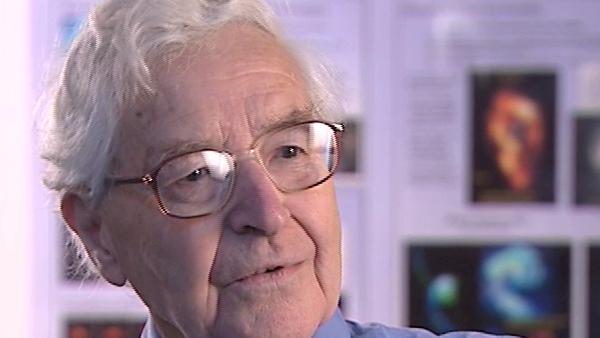My PhD was totally to do with the ionosphere and, having worked out the theory and got some observations, I think one of my happiest moments was not just the publication of the papers, but I remember the first time I measured an ionospheric wind. I set up a very simple experiment just a mile from here where we're sitting, on the old rifle range. I set up two simple radio telescopes and looked at Cassiopeia A and got the scintillations at two places on the ground and saw that they were identical almost, but with a time lag which showed that the scintillation pattern – this… this cloud pattern of radiations – was moving across the ground. And I was able to measure the speed of that from the time delay. Of course, I only got one component of the velocity because I only had a single line. I had one antenna just right behind the rugger ground and the other one was a bit… was about half a mile further off. And the delay, so the speed up there at a height of about a 100… 300 km, you know, that's about 200 miles high, something like that, was… what was it that night? It was about 160 miles per hour, which I thought was quite fast. And as I cycled home in the moonlight I realised I was the only person in the whole world who actually knew the speed of the wind was 160 miles up. You know, I'd done something new and this is… this is the stimulus that keeps you going in research, that… that kind of thing. I've still got that record, actually, in my desk. It's a bit faded now but we… we didn't have all this digital recording. We had pens making marks on papers like a medical chart, you know, a heart machine, and you could see the delay as these pens went along and I think that… that was a memorable moment in my research career. That happened after I'd been doing research for about 18 months, 2 years, and that got me… got me moving and that led on. One thing led to another.
My PhD was all to do with the ionosphere but then we discovered radiation coming through the solar corona; we discovered that this solar corona, which in those days you could only see at total eclipse in optical astronomy, was affecting radiation coming from, well, the Crab Nebula in particular because that passes rather close to the Sun, but also the other sources did it too. But you were getting radio scattering of radiation from clouds of plasma surrounding the Sun and I began to do that in the late… late 1950s. And that took my research on, away from terrestrial things, to the Sun again and then I started to research the Sun's atmosphere. And that took me a number of years.





